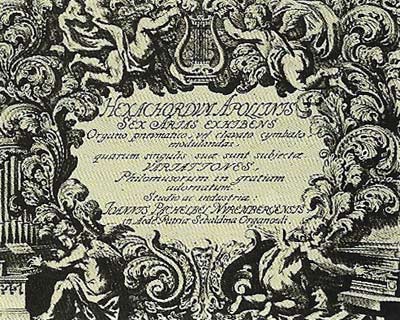Pachelbel, Johann (1653–1706)

The title of Pachelbel's Hexachordum Apollinis, printed in Nuremberg, six arias for organ or harpsichord, with variations.
Johann Pachelbel, an important predecessor of J. S. Bach, is remembered today chiefly for a single composition, known as "Pachelbel's Canon" (of which many versions – including rock – now exist). But in his day he was much admired for his contribution to German Protestant church music, particularly for the organ.
Born in Nuremberg, he began his career as organist at St Stephen's Cathedral in Vienna. In 1677 he became organist at Bach's birthplace, the Thuringian town of Eisenach, but a year later he moved a few miles east to Erfurt, where for the next 12 years he was organist at the Predigerkirche.There he came into contact with members of the Bach family (he was godfather to one of J. S. Bach's sisters, and taught his elder brother Johann Christoph, who in turn taught Johann Sebastian).
While at Erfurt, Pachelbel married, only to lose his wife and their baby son two years later in a plague epidemic. He remarried in 1684, and raised a family of seven children. He then spent two years as court organist at Stuttgart, and three as town organist at Gotha, before finally moving back to his own birthplace as organist of St Sebald's Church.
Pachelbel's music
The organ chorales composed by Pachelbel – complex polyphonic pieces based on Protestant hymn tunes – had enormous influence on those of Bach. He was also a master of various other keyboard genres of his time, including toccatas, ricercari, fantasias, chaconnes, and variations – his Hexachordum Apollinis (1699) is a group of six arias with variations for organ or harpsichord, each in one of five keys making up a perfect fifth.
Pachelbel also wrote six suites for two violins and keyboard, the masterful and justly famous Canon (a set of 28 canonic variations originally scored for three violins and bass), motets, sacred concertos, and 11 fine settings of the Magnificat for chorus and instruments, intended for the Vesper services in Nurmberg.


